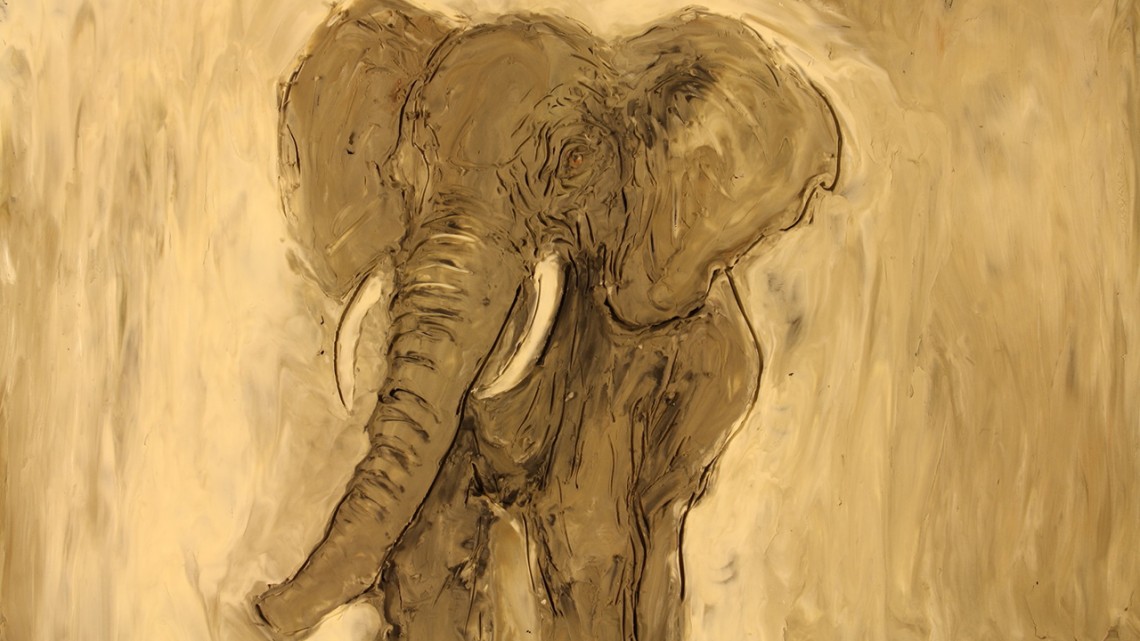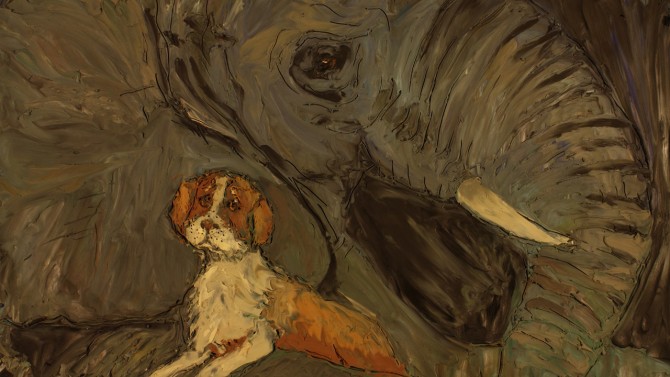
A still from Lynn Tomlinson’s most recent animated film, “The Elephant’s Song.” Tomlinson uses colorful, clay-on-glass animation to create her animation style.
Alumna animator earns festival awards for newest film
By Kathy Hovis
Looking at an animated film by Lynn Tomlinson ’88, a viewer feels like they’re in front of an impressionist painting by Van Gogh or the Hudson River School painters, or riding the waves with fishermen in a work by Winslow Homer.
Tomlinson uses a process where colorful oil-based modeling clay is spread thinly on a glass sheet and moved frame-by-frame like a moving finger painting.
Her most recent work, “The Elephant’s Song,” tells the story of Old Bet, the first circus elephant in America. The story, narrated by a farm dog who becomes Bet’s friend, has won awards at festivals. Tomlinson visited Ithaca in late October to show an excerpt from the film and gave a talk at Cornell Cinema.
Tomlinson created the story with her son, Sam Saper, a college senior who also composed the song for the film, which weaves the story of Old Bet with historic footage recreated during the choruses.
While the dog tells the story during the verses of the song, Old Bet sings the choruses, which are animated with oil pastel on video frames printed from archival films, paintings and photographs. Those frames illustrate how elephants have been used – and misused – throughout history for their ivory and by circuses and landowners.
Tomlinson spends at least three hours animating for each second of film that appears on screen. The seven-minute “Elephant’s Song” took her more than 1,200 hours to create.
At Cornell, Tomlinson enrolled as a biology major but always pursued art. She ended up an English major, but got turned on to studying film after taking a class her junior year, “Myth onto Film,” taught by anthropology professor Robert Ascher.
“The class mixed animation with theories of myth and anthropology,” she said. “We drew right onto 35mm film with tiny pens.”
She took two film production courses in her senior year and made animation projects. She also created a documentary about student businesses at Cornell.
Tomlinson went on to earn master’s degrees in art education, communication and studio art. In graduate school, she discovered clay-on-glass animation and has been developing that technique ever since.
Her work table holds a 6-inch by 10-inch glass plate lit from the top, with bits of clay all over and a food warmer underneath to keep it pliable. “Oil-based kids clay comes in great colors,” Tomlinson said. “Sometimes, I’ll spend a couple of hours kneading colors together to make a palette. But usually it looks like a mess – smeared bits of goo every which way.”
Along with short works, Tomlinson has created films for PBS and “Sesame Street,” along with sculptures and ceramics and six large-scale collaborative community art projects in Florida, including four mosaics. Her animation was also featured in a video, “Fired Up,” that went viral in 2017 featuring a speech by President Barack Obama.
She is assistant professor of electronic media and film at Towson University and for 10 summers spent time in Ithaca teaching an animation class in the Department of Performing and Media Arts.
Inspiration for “The Elephant’s Song” came from a podcast that told the story of Old Bet.
“The loneliness really hit me, of the elephant being the only one of its species, alone in the United States,” she said. “The diasporic narrative seemed very pertinent today.”
The sound effects for the elephants in the film come from The Elephant Listening Project at Cornell’s Lab of Ornithology. “The Elephant’s Song” will be available online in a year or so, once it has finished its film festival run. Tomlinson’s previous film, “The Ballad of Holland Island House,” can be viewed here.
Media Contact
Get Cornell news delivered right to your inbox.
Subscribe



